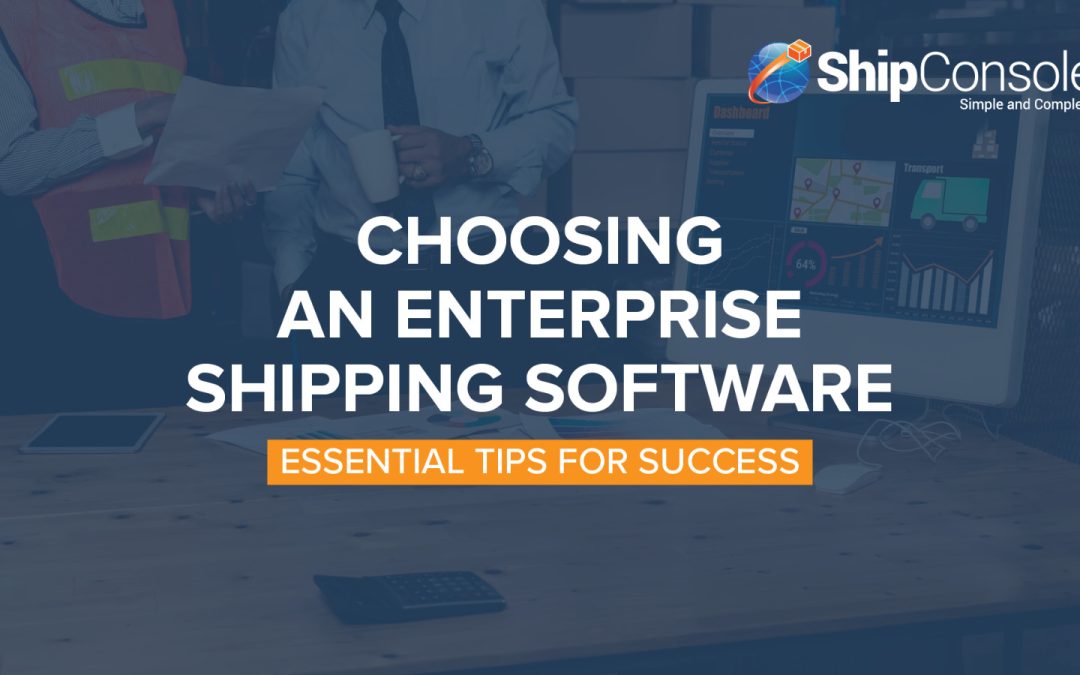Selecting the right enterprise shipping software is a critical decision for any business dealing with logistics and supply chain management. With the plethora of choices available, it’s important to understand your needs and market landscape to make an informed decision. This blog will take you through the process of picking the right enterprise shipping solution for your ERP system
Awareness
Identifying the Problem
It all starts with the first step in selecting shipping software: recognizing all the challenges faced in your existing shipping process. Common issues include high shipping costs, slow delivery times, lack of visibility, and inefficient handling of multiple carriers. These will help you identify what you need in your shipping solution.
Defining Your Needs
Now that you’re done with the definition of the problem, take your time and list all your specific needs. Certified, pre-built Integration with your ERP system and multi-carrier, multi-modal shipping with rate shopping, real-time tracking, and shipment notifications could be some of your primary needs. Define your must-have and nice-to-have features to guide the search.
Research
Finding a Potential Solution
Now that you have your needs, you can start researching the potential solution. Look for software supporting multi-carrier shipping, and multi-modal shipping that is pre-integrated with your ERP system. Compare different options that meet your identified needs.
Feature Comparison
Create a feature-comparison matrix to contrast the features of different solutions. Must-have features in a versatile shipping solution could include real-time tracking, advance shipping notifications, freight cost management, and support for multiple shipping carriers and modes of transport. These will ensure smoother functioning of your warehouse and back-office operations.
ERP Certified/Carrier Certified
Make sure the shipping software is both Carrier-certified and certified by your ERP vendor. Certifications mean that the software has been through a testing and validation process to work with your existing systems and carriers, dramatically reducing the risk of issues around integration.
Scalability and Flexibility
It is crucial to ensure that the shipping software can adapt to custom business rules and scale globally with the growth of your business as you add additional warehouses.
Carrier Network
Evaluate the shipping software’s supported carriers for parcels and freight to determine the extensiveness of the network list and the ease of adding new carriers.
Demos
Request demos from shortlisted vendors to see the software in action. Demos are hands-on and will let you evaluate everything from the user interface and ease of use to how well the software meets your needs. Pay attention to how the software handles multi-carrier, multi-modal shipping and how it integrates with your ERP.
Evaluating & Selecting
How To Negotiate Price, Terms and Service Agreements
Once you have narrowed the options, negotiate the price, terms, and service agreement. Be sure to clarify the total cost of ownership, by drawing out any hidden fees or extra charges for updates and support.
Reference Calls
Ask for reference calls with current users of the software. Ask about their experience with software implementation, customer support, and their overall level of satisfaction. This gives you a real-world view of the software’s performance and the vendor’s reliability.
Choose a Vendor
Identify the one that fits best with your business requirements and offers good value. Consider the total cost of ownership, feature set, user feedback, and how well the software matches your identified needs.
Implementation and Optimization
Kick-off
The implementation phase of your shipping software starts right after you’re done selecting the software. Begin with a kick-off meeting to get aligned between your team and the vendor on the project timeline, key milestones, roles, and responsibilities.
Go-Live
Perform rigorous testing with your end users and ensure that users have been adequately trained to use the software. Ensure all integrations with your ERP and carriers work perfectly before going live with the new system.
Technical Support
Reliable technical support is essential in addressing problems that may arise post-implementation. Go with a vendor that provides excellent customer support along with good documentation of their product.
Upgrades
Ensure the software is continuously updated to remain compatible with future ERP releases and carrier updates, keeping your operations efficient and up to date.
ShipConsole Integration with Oracle
ShipConsole offers a comprehensive suite of solutions for both outbound and inbound logistics for all Oracle ERPs including Oracle Cloud (Fusion) ERP E-Business Suite, JD Edwards EnterpriseOne, and NetSuite. Key features of ShipConsole include out-of-box integration with Oracle ERPs, multi-carrier, multi-modal shipping, freight quoting, rate shopping, real-time tracking, advance ship notifications, a mobile app for E-Signing BOLs, employee shipping, and inbound tracking. Backed by excellent software implementation and customer support teams, ShipConsole is an ideal pick if you want to optimize your shipping processes for Oracle.
Conclusion
That means picking shipping software is about doing your research rigorously, critically evaluating what you actually need, and making it absolutely clear. If these steps are followed and an established solution like ShipConsole is considered, you will find that it substantially enhances your efficiency in shipping and accordingly contributes to a noticeable overall difference in your bottom line.

Pavan Telluru works as a Product Manager at ShipConsole. He brings over a decade of experience to his current role where he’s dedicated to conducting product demos to prospects and partners about how to organizations can efficiently manage their shipping execution process. He also leads marketing efforts at ShipConsole.


